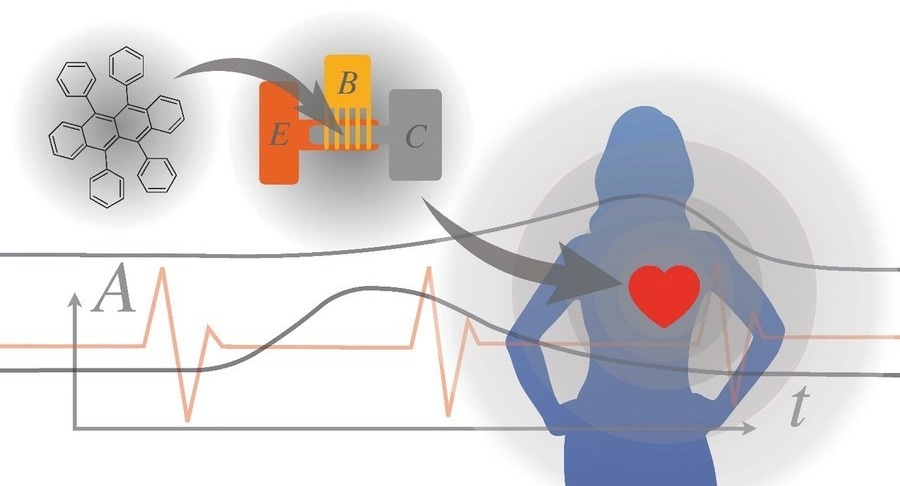For over two decades, Professor Karl Leo has been thinking about the realization of this component. Now, it is a reality: At the Institute for Applied Physics at the TU Dresden, his research team has provided the first highly effective organic bipolar transistor.
 Organic bipolar transistors can also handle demanding data processing and transmission tasks on flexible electronic elements, e.g. here for electrocardiogram (ECG) data. Image Credit: Technische Universitat Dresden.
Organic bipolar transistors can also handle demanding data processing and transmission tasks on flexible electronic elements, e.g. here for electrocardiogram (ECG) data. Image Credit: Technische Universitat Dresden.
This paves the way for entirely new ideas for organic electronics — both in data processing and transmission, as well as in medical technology applications. The study outcomes have currently been reported in the renowned specialist journal “Nature”.
The innovation of the transistor in 1947 by Shockley, Bardeen, and Brattain at Bell Laboratories guided the age of microelectronics and revolutionized the lives of humans. Initially, the alleged bipolar transistors were invented, in which positive and negative charge carriers contribute to the present transport, unipolar field-effect transistors were only added afterward.
The increasing performance as a result of the scaling of silicon electronics in the nanometer range has considerably accelerated data processing. However, this very rigid technology is less suitable for new types of flexible electronic components, such as rollable TV displays or for medical applications on or even in the body.
For such applications, transistors made of organic, that is, carbon-based semiconductors, have come into focus in the past few years. Organic field-effect transistors were first introduced as early as 1986. However, their performance still lags well behind silicon components.
A research team headed by Professor Karl Leo and Dr. Hans Kleemann at the TU Dresden has been successful in illustrating an organic and highly efficient bipolar transistor. What seemed vital to this was the use of highly ordered thin organic layers.
This newly-developed technology seems to be several times quicker compared to the earlier organic transistors, and for the first time, the components have attained operating frequencies in the gigahertz range, that is, over a billion switching operations performed every second.
Dr. Shu-Jen Wang, who co-led the project with Dr. Michael Sawatzki, explained, “The first realization of the organic bipolar transistor was a great challenge, since we had to create layers of very high quality and new structures. However, the excellent parameters of the component reward these efforts!”
We have been thinking about this device for 20 years and I am thrilled that we have now been able to demonstrate it with the novel highly ordered layers. The organic bipolar transistor and its potential open up completely new perspectives for organic electronics, since they also make demanding tasks in data processing and transmission possible.
Karl Leo, Professor, Institute of Applied Physics, Technische Universitat Dresen
Feasible future applications are, for instance, smart patches fitted with sensors that process the sensor data in a local and wireless manner to be communicated outside.
Journal Reference:
Wang, S.-J., et al. (2022) Organic bipolar transistors. Nature. doi.org/10.1038/s41586-022-04837-4.
Source: https://tu-dresden.de/?set_language=en